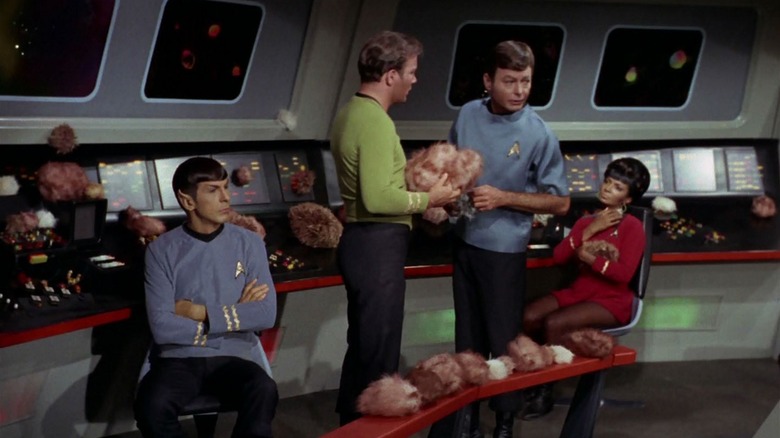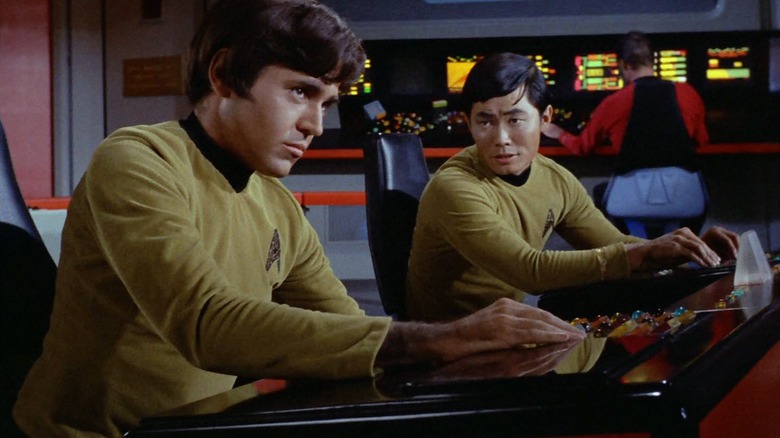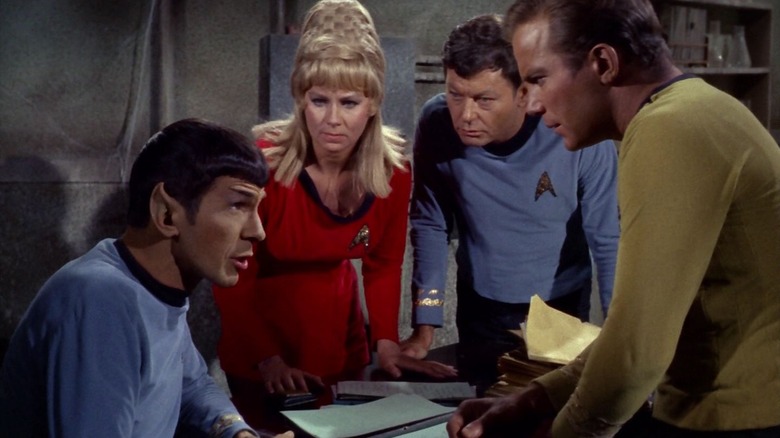Gene Roddenberry’s “Star Trek” could happen in a post-capitalist utopia whereby no character longs for wealth, however right here in our society, its actors can’t stay with that luxurious.
Trekkies will be capable to let you know that “Star Trek” wasn’t an enormous hit when it first aired from 1966 to 1969. It undoubtedly had a small and passionate cluster of followers, and the present was saved from cancelation at the least as soon as due to a concerted letter-writing marketing campaign, nevertheless it was by no means a top-10 sort of present within the rankings. “Star Trek” would not turn into a cultural phenomenon till it started airing in reruns within the mid-Nineteen Seventies. By then, it was extra extensively accessible, new superfans emerged, and “Star Trek” conventions grew to become a factor. Gene Roddenberry appeared at these conventions, and he started to relitigate his personal present, with fan encouragement, realizing that he had certainly created a utopian textual content.
The celebrities of “Star Trek,” in the meantime, had been capable of leverage their restricted earnings from the present into conference appearances, as they weren’t getting any cash in residuals. As unfair as it might appear, the unique solid members of the sequence — William Shatner, Leonard Nimoy, Nichelle Nichols, DeForest Kelley, George Takei, Walter Keonig, and James Doohan — did not get any royalty funds for these Nineteen Seventies reruns. Doohan, in a 1979 interview with the Fort Price Star-Telegram (quoted by the Heroes & Icons website), admitted that neither he nor his co-stars acquired a dime from “Star Trek” reruns after the yr 1971. In 2020, William Shatner said on Twitter that he receives no royalties for something “Star Trek”-related earlier than 1973.
Those that assume all TV stars had been capable of stay excessive on the hog primarily based solely on residuals for infinite reruns have to keep in mind that a lot of them had been stiffed out of stated residuals due to unfair contracts.
No actors acquired a dime in residuals after the early Nineteen Seventies
Shatner’s above-mentioned Twitter beef noticed him arguing with a bitter fan about his private wealth. Shatner recalled that the late-Sixties weren’t a rosy time for working actors, because the assumed sample of royalty funds hadn’t turn into an trade normal. He wrote:
“Something earlier than 1973 (that features ‘Star Trek’ Unique Collection) does not pay a cent in royalties. So please do not suppose you personal me or I owe you one thing for watching. It does not work like that.”
Shatner additionally talked about his lack of royalty funds on the Transporter Room 3 podcast, hosted by IGN (and reported on by The Hollywood Reporter), clarifying that in these days, no actor on any TV sequence acquired residuals for reruns after just a few years. In any case, it was thought-about most individuals assumed no TV present would proceed to air in reruns for quite a lot of years anyway. As such, no studios bothered to jot down any royalty-based contracts for any actors. Nobody may have predicted that “Star Trek” would strike a decades-long syndication deal that may preserve it on the air for actually many years.
Again within the Fort Price Star Telegram interview, Doohan famous that the unfair funds for the “Star Trek” solid was a motivating consider a widespread contract restructuring all through Hollywood. He stated that “Our scenario was what prompted the Display Actors Guild to alter the principles. […] Now, you receives a commission for all reruns.” That, after only three years on the air.
On SAG’s own website, it’s written that royalties did not exist earlier than 1960. A profitable strike ultimately put royalties contracts into play, however sadly, retroactive funds weren’t a part of the negotiations, and studios didn’t must pay royalties to actors in motion pictures launched earlier than 1960. Something made in 1960 and past, nevertheless, concerned residual funds.
A short historical past of residuals
It was in 1960 that SAG additionally lastly arrange a pension fund. For the following 14 years, nevertheless, TV stars had been nonetheless getting stiffed. “Reruns” had been nonetheless, it appears, a novel idea, or at the least an idea that studios had been keen to disregard when it got here to paying royalties to their actors. Falling in keeping with Doohan’s and Shatner’s feedback, SAG “collectively negotiated the contract overlaying primetime dramatic programming on the key tv networks for the primary time” in 1974.
In 1980, leisure unions needed to go on strike once more when studios tried to withhold royalties for house video gross sales and for pay TV like cable. Certainly, one would possibly discover that almost all SAG or WGA strikes have been, all through its historical past, in regards to the withholding of residuals. The union’s longest strike got here in 1988, and that was largely about how residuals for TV broadcasts in worldwide markets weren’t being paid. In 2007 and 2008, the unions went on strike once more after studios didn’t pay them residuals for on-line broadcasts. Each new expertise, it appears, is seen as a brand new means by studios to aim to stiff SAG members.
This was certainly true of the 2023 strikes, which had been about making an attempt to get residuals from the infamous Streaming Wars. Streaming companies, due to a precedent set by Netflix, by no means launched their viewership numbers, and did not really feel any urge to pay royalties to actors because of this. The unions had been capable of negotiate a fee system, and in addition demanded that studios cease utilizing A.I. tech to scan their faces and use their photos free of charge. The 2023 strikes had been the second-longest within the group’s historical past … by at some point.
Fortunately, the “Star Trek: The Subsequent Technology” solid benefitted from these earlier strikes, and have been capable of stay off residuals. Within the case of actor Wil Wheaton, who performed Wesley Crusher, it was all he had for years.
Gene Roddenberry’s “Star Trek” could happen in a post-capitalist utopia whereby no character longs for wealth, however right here in our society, its actors can’t stay with that luxurious.
Trekkies will be capable to let you know that “Star Trek” wasn’t an enormous hit when it first aired from 1966 to 1969. It undoubtedly had a small and passionate cluster of followers, and the present was saved from cancelation at the least as soon as due to a concerted letter-writing marketing campaign, nevertheless it was by no means a top-10 sort of present within the rankings. “Star Trek” would not turn into a cultural phenomenon till it started airing in reruns within the mid-Nineteen Seventies. By then, it was extra extensively accessible, new superfans emerged, and “Star Trek” conventions grew to become a factor. Gene Roddenberry appeared at these conventions, and he started to relitigate his personal present, with fan encouragement, realizing that he had certainly created a utopian textual content.
The celebrities of “Star Trek,” in the meantime, had been capable of leverage their restricted earnings from the present into conference appearances, as they weren’t getting any cash in residuals. As unfair as it might appear, the unique solid members of the sequence — William Shatner, Leonard Nimoy, Nichelle Nichols, DeForest Kelley, George Takei, Walter Keonig, and James Doohan — did not get any royalty funds for these Nineteen Seventies reruns. Doohan, in a 1979 interview with the Fort Price Star-Telegram (quoted by the Heroes & Icons website), admitted that neither he nor his co-stars acquired a dime from “Star Trek” reruns after the yr 1971. In 2020, William Shatner said on Twitter that he receives no royalties for something “Star Trek”-related earlier than 1973.
Those that assume all TV stars had been capable of stay excessive on the hog primarily based solely on residuals for infinite reruns have to keep in mind that a lot of them had been stiffed out of stated residuals due to unfair contracts.
No actors acquired a dime in residuals after the early Nineteen Seventies
Shatner’s above-mentioned Twitter beef noticed him arguing with a bitter fan about his private wealth. Shatner recalled that the late-Sixties weren’t a rosy time for working actors, because the assumed sample of royalty funds hadn’t turn into an trade normal. He wrote:
“Something earlier than 1973 (that features ‘Star Trek’ Unique Collection) does not pay a cent in royalties. So please do not suppose you personal me or I owe you one thing for watching. It does not work like that.”
Shatner additionally talked about his lack of royalty funds on the Transporter Room 3 podcast, hosted by IGN (and reported on by The Hollywood Reporter), clarifying that in these days, no actor on any TV sequence acquired residuals for reruns after just a few years. In any case, it was thought-about most individuals assumed no TV present would proceed to air in reruns for quite a lot of years anyway. As such, no studios bothered to jot down any royalty-based contracts for any actors. Nobody may have predicted that “Star Trek” would strike a decades-long syndication deal that may preserve it on the air for actually many years.
Again within the Fort Price Star Telegram interview, Doohan famous that the unfair funds for the “Star Trek” solid was a motivating consider a widespread contract restructuring all through Hollywood. He stated that “Our scenario was what prompted the Display Actors Guild to alter the principles. […] Now, you receives a commission for all reruns.” That, after only three years on the air.
On SAG’s own website, it’s written that royalties did not exist earlier than 1960. A profitable strike ultimately put royalties contracts into play, however sadly, retroactive funds weren’t a part of the negotiations, and studios didn’t must pay royalties to actors in motion pictures launched earlier than 1960. Something made in 1960 and past, nevertheless, concerned residual funds.
A short historical past of residuals
It was in 1960 that SAG additionally lastly arrange a pension fund. For the following 14 years, nevertheless, TV stars had been nonetheless getting stiffed. “Reruns” had been nonetheless, it appears, a novel idea, or at the least an idea that studios had been keen to disregard when it got here to paying royalties to their actors. Falling in keeping with Doohan’s and Shatner’s feedback, SAG “collectively negotiated the contract overlaying primetime dramatic programming on the key tv networks for the primary time” in 1974.
In 1980, leisure unions needed to go on strike once more when studios tried to withhold royalties for house video gross sales and for pay TV like cable. Certainly, one would possibly discover that almost all SAG or WGA strikes have been, all through its historical past, in regards to the withholding of residuals. The union’s longest strike got here in 1988, and that was largely about how residuals for TV broadcasts in worldwide markets weren’t being paid. In 2007 and 2008, the unions went on strike once more after studios didn’t pay them residuals for on-line broadcasts. Each new expertise, it appears, is seen as a brand new means by studios to aim to stiff SAG members.
This was certainly true of the 2023 strikes, which had been about making an attempt to get residuals from the infamous Streaming Wars. Streaming companies, due to a precedent set by Netflix, by no means launched their viewership numbers, and did not really feel any urge to pay royalties to actors because of this. The unions had been capable of negotiate a fee system, and in addition demanded that studios cease utilizing A.I. tech to scan their faces and use their photos free of charge. The 2023 strikes had been the second-longest within the group’s historical past … by at some point.
Fortunately, the “Star Trek: The Subsequent Technology” solid benefitted from these earlier strikes, and have been capable of stay off residuals. Within the case of actor Wil Wheaton, who performed Wesley Crusher, it was all he had for years.





















